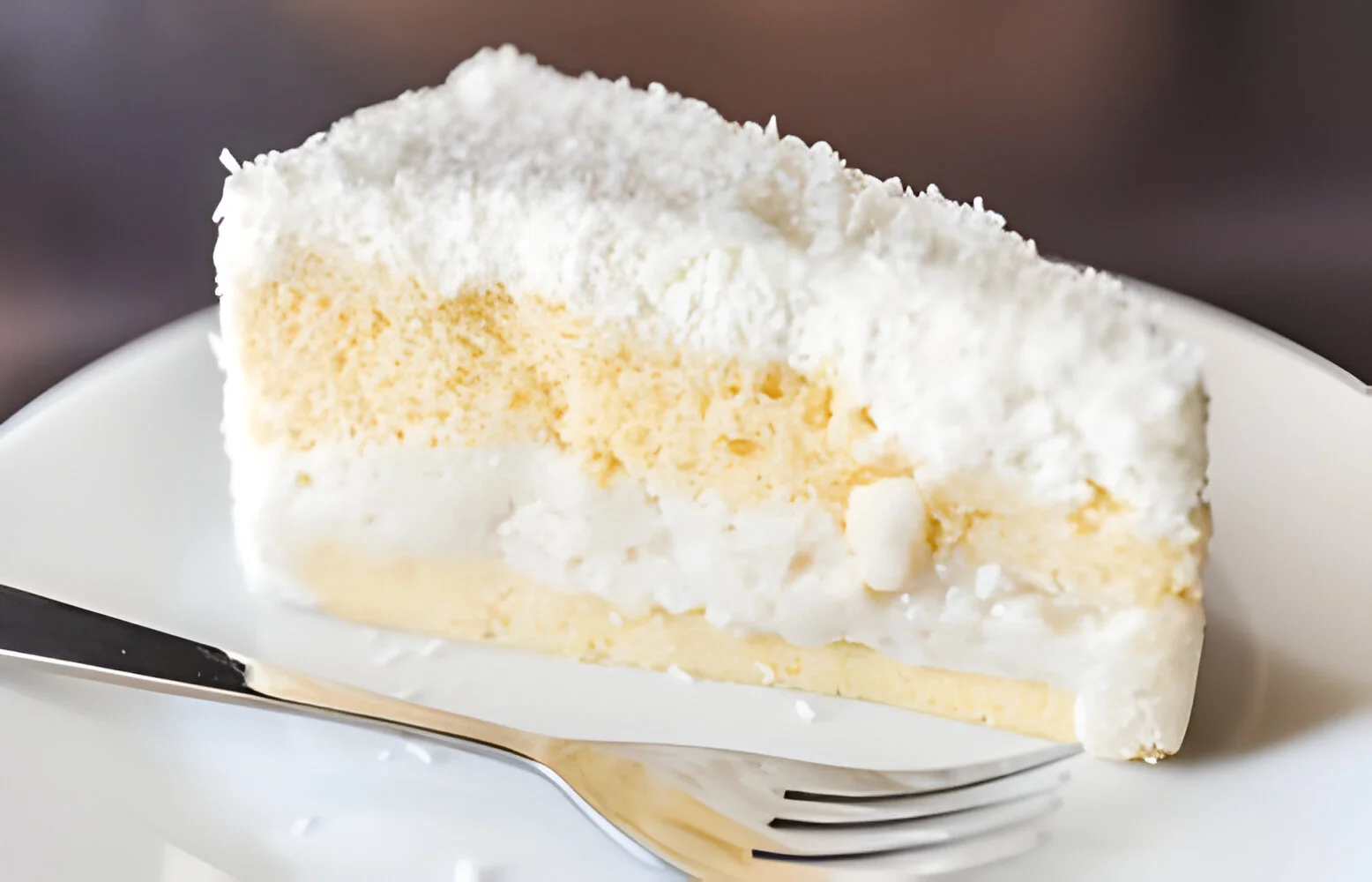Table of Contents
Have you ever whisked, mixed, and baked your heart out, only to pull a disappointingly dense coconut cake out of the oven? You’re not alone. This delightful dessert, with its promise of a fluffy, light texture and rich coconut flavor, often turns into a baking conundrum. But fret not! This article is your compass in the stormy sea of coconut cake baking. From selecting the right ingredients to mastering the mix, we’re diving deep into the secrets that transform your coconut cake density into a cloud-like marvel. So, preheat your ovens, and let’s embark on this culinary journey to ensure your next coconut cake is nothing short of perfection.
Introduction to Coconut Cake
Understanding Coconut Cake
Coconut cake, a beloved dessert known for its moist, fluffy texture and tropical flavor, has long been a staple at gatherings. However, achieving that perfect lightness can sometimes feel like a culinary puzzle. What’s supposed to be a tender and airy cake might end up more like a dense, heavy block.
Common Issues with Homemade Coconut Cake
Many bakers have faced the challenge of a dense coconut cake. It’s a widespread issue that can dampen the spirit of even the most enthusiastic baker. But, why does this happen? Often, it’s the little things—like how we mix our batter or the quality of ingredients—that make a big difference.
The Importance of Texture in Coconut Cake
The texture of a coconut cake is paramount; it’s what sets it apart from other cakes. It should be light and delicate, melting away in your mouth with each bite. Achieving this texture requires a blend of science and art, understanding the roles of ingredients, and how they interact during the baking process.
Stay tuned as we unravel the mysteries behind a fluffy coconut cake, ensuring your baking adventures end in success, not with a dense disappointment. For more baking insights and delicious recipes, don’t forget to visit Operacook.
Key Ingredients for the Perfect Coconut Cake
Creating the perfect coconut cake is akin to a symphony; every ingredient plays a crucial role in the final masterpiece. Specifically addressing coconut cake density, the choice of coconut product can greatly influence both flavor and texture. Unsweetened coconut flakes provide a subtle, natural sweetness and a delightful texture, crucial for avoiding overwhelming moisture that can contribute to coconut cake density. On the other hand, coconut milk adds necessary moisture to the batter, contributing to a tender crumb, essential in managing the density of coconut cake.
The Role of Flour and Its Alternatives
Flour is the backbone of any cake, providing structure and significantly affecting the density of coconut cake. For a lighter texture, cake flour is pivotal due to its lower protein content, which minimizes gluten formation — a key factor in reducing coconut cake density. If cake flour isn’t on hand, a blend of all-purpose flour and cornstarch can come to the rescue, mimicking the softness that cake flour brings to the table, crucial for achieving the right coconut cake density.
Understanding the Function of Eggs in Cake Batter
Eggs are the binding soul of your cake, crucial for managing the density of coconut cake, with whites and yolks serving different purposes. While yolks add richness and tenderness to the batter, the whites can be whipped and folded into the mix to introduce air, promoting a fluffier structure. This delicate balance is essential for ensuring your cake rises beautifully without contributing to undue density in coconut cake.
Mixing Methods and Their Impact
The way you combine your ingredients can dramatically affect your cake’s density. The creaming method, where sugar and butter are beaten together before adding eggs, introduces air into the batter, promising a lighter cake, pivotal for addressing coconut cake density. Conversely, the all-in-one method combines all ingredients simultaneously, which, while simpler, often results in a denser texture. Therefore, taking the time to cream your butter and sugar might just be the secret to avoiding a heavy coconut cake and effectively managing coconut cake density.
In the world of baking, understanding and mastering the roles of ingredients and techniques is pivotal for controlling coconut cake density. As we continue our journey to the perfect coconut cake, remember that each step, from selecting the right type of flour to the mixing method, plays a critical role in achieving that dreamy, light texture and managing coconut cake density. Stay tuned for our next installment, where we’ll troubleshoot common issues and explore solutions to the dreaded cake density dilemma, ensuring your coconut cake turns out just right.
Troubleshooting Dense Coconut Cake
Common Causes of Density in Coconut Cakes
A dense coconut cake can be a disappointing outcome for any baker. Often, the culprit lies in the nuances of the baking process. Overmixing the batter, for example, can develop the gluten in the flour too much, leading to a heavier cake. Similarly, incorrect measuring of ingredients can throw off the delicate balance required for a light and airy texture. It’s crucial to use a scale or precise measuring cups to ensure accuracy.
Oven Temperature and Baking Time
The heat of your oven is like the conductor of an orchestra; it needs to be just right. Baking your cake at too low a temperature can result in a dense texture, as the batter doesn’t set quickly enough to capture the air bubbles created during mixing. Conversely, an oven that’s too hot can cause the cake to rise rapidly and then collapse. A reliable oven thermometer can be a baker’s best friend to ensure accurate temperature settings.
Measuring Ingredients Precisely
Precision is key in baking. A cake can turn out too dense if there’s too much flour or not enough leavening agent. Spoon and level your flour — don’t scoop it directly from the container, as this can compact it. Similarly, ensure your baking powder and soda are fresh; expired leaveners lose their effectiveness, leading to a flat and dense cake.
Expert Tips for Fluffy Coconut Cake
Professional Baking Secrets
Achieving the perfect coconut cake texture involves not just what you put into the cake, but how you do it. One secret from professional bakers is to sift dry ingredients not once, but twice. This aerates the flour, making it lighter and easier to mix into a smooth batter without overworking. Another tip is to use room-temperature ingredients, which blend more easily and create a more uniform batter.
Enhancing Coconut Flavor without Adding Density
To imbue your cake with that tropical coconut essence without weighing it down, opt for coconut extract or coconut oil. These concentrated flavors add a punch without altering the cake’s texture. Remember, a little goes a long way with extracts, so start with a small amount and adjust according to taste.
The Science Behind Leavening Agents
Understanding the role of leavening agents can make or break a cake’s texture. Baking powder, for instance, starts working the moment it gets wet, while baking soda requires an acid to activate. For a balanced rise, ensure your recipe includes the right type and amount of leavening agent. Additionally, folding in beaten egg whites can introduce extra air into the batter, helping to lift the cake as it bakes.
Navigating the nuances of coconut cake baking can be a journey filled with trials and triumphs. By understanding the common pitfalls and applying expert tips, you’re well on your way to creating a cloud-like coconut cake that’s as light as a feather and rich in flavor. Remember, baking is both an art and a science—each attempt brings you one step closer to perfection.
Discover Best Coconut Cake Bake Off – A comprehensive review of different coconut cake recipes to understand what works best.
FAQs on Coconut Cake Challenges
When embarking on the journey to bake the perfect coconut cake, several questions and concerns may arise, particularly about achieving the ideal cake density. Here, we address some of the most common queries based on “People Also Ask” sections to help you navigate through the intricacies of coconut cake baking.
Why does my coconut cake come out dense instead of fluffy?
One of the primary reasons a coconut cake might turn out dense rather than fluffy is overmixing the batter. When you mix cake batter excessively, the gluten in the flour develops too much, leading to a tougher, denser cake structure. Additionally, incorrect measurements, especially of flour and leavening agents, can also affect the cake’s density. It’s crucial to measure your ingredients accurately and mix just until the ingredients are combined.
Can the type of coconut product I use affect my cake’s texture?
Absolutely. The variety of coconut products, such as coconut milk, coconut cream, and shredded coconut, can have different impacts on your cake’s texture. Coconut milk and coconut cream add moisture and fat, which can help make the cake tender. However, too much can weigh down the batter, resulting in a denser cake. Shredded or desiccated coconut, when added in moderation, contributes to the cake’s coconut flavor without significantly affecting the texture. However, excessive amounts can make the cake heavy.
How do I prevent my coconut cake from being too heavy?
To prevent your coconut cake from becoming too heavy, ensure you’re using the right balance of wet to dry ingredients. Too much liquid can make the batter too heavy and dense. Additionally, consider the creaming method for mixing your butter and sugar, as it incorporates air and can help achieve a lighter texture. Be sure also to sift your flour and other dry ingredients to incorporate air and avoid overpacking when measuring. Finally, be careful not to overmix the batter once the flour is added; mix just until the ingredients are combined to keep the cake light and fluffy.
Can I substitute coconut flour for all-purpose flour in my coconut cake?
One common query revolves around using coconut flour as a substitute for all-purpose flour in cake recipes. Coconut flour is unique; it’s highly absorbent and can significantly change the texture of your cake. While it’s tempting to use it for an intensified coconut flavor, it’s not a straightforward swap.
To start, you can substitute 1/4 cup of coconut flour for every 1 cup of all-purpose flour. However, since coconut flour lacks gluten, it requires additional moisture to maintain the structure of your cake.
For every 1/4 cup of coconut flour used, add one extra egg to help with moisture and texture. This adjustment will prevent your cake from becoming too dense.
That said, experimenting is key. The precise balance can vary depending on the specific recipe you’re working with, so be prepared to test and tweak as you go.
How do I ensure my coconut cake stays moist after baking?
To keep a coconut cake moist after baking, consider these tips. Brush cake layers with simple syrup (equal parts sugar and water, boiled and cooled) before assembling to add moisture directly. Store the cake in an airtight container or wrap it well in plastic wrap to prevent drying out. If your cake has frosting, it can help seal in moisture, but proper storage is still key. Refrigeration can extend freshness, but allow the cake to come to room temperature before serving for optimal flavor and texture.
Conclusion and Final Thoughts
Crafting the perfect coconut cake is a journey filled with delicate balances, precise techniques, and a sprinkle of baking magic. We’ve ventured through the selection of key ingredients, explored the impact of mixing methods, delved into troubleshooting common issues, and shared professional tips to ensure your cake rises to the occasion, both literally and metaphorically.
The journey to a fluffy coconut cake is not just about following a recipe to the letter but understanding the why behind each step. Why sift flour twice? To incorporate air for lightness. Why measure ingredients with precision? To maintain the delicate balance that ensures a tender crumb. And why experiment with different coconut products? To discover the perfect harmony of moisture and flavor that sings of tropical islands and sun-kissed beaches.
Remember, each baking endeavor is an opportunity to learn and grow. If your coconut cake comes out denser than desired, consider it a stepping stone, not a stumbling block. Adjust, adapt, and try again. The perfect coconut cake texture is within reach, armed with the insights and tips we’ve shared.
As we conclude our guide, take these lessons and tips back to your kitchen. Experiment with confidence, bake with love, and above all, enjoy the process. The ultimate reward is not just a cake that delights the palate but the joy found in creating something beautiful and delicious.
Here’s to light, airy, and irresistibly coconut cakes that elevate your baking repertoire and enchant your taste buds. Happy baking!





